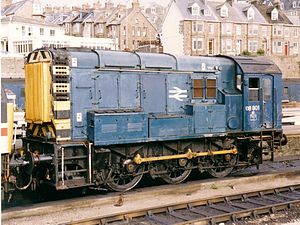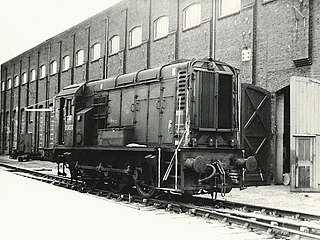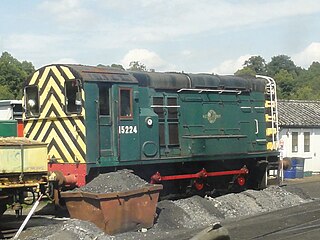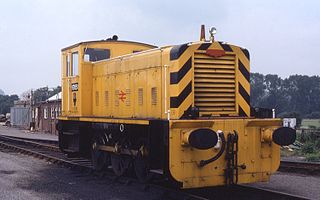| Numbers | Owners | Location | Comments |
|---|
| 08220 | English Electric Preservation | Nottingham Transport Heritage Centre, Ruddington | |
| 08308, 08523, 08573, 08613, 08885, 08936 | RMS Locotec | Weardale Railway, Wolsingham, County Durham | - 08308 carries the number "23". In 2023 it became a battery powered prototype for Positive Traction of Chesterfield. [16]
- 08613 carries the symbol "H064"
- 08885 carries the symbol "H042" and the number "18"
|
| 08375 | Port of Boston, Lincolnshire | |
| 08423, 08788, 08847, 08874 | PD Ports, Grangetown, Middlesbrough | - 08423 carries the name LOCO 2 and the number "14"
- 08847 carries the name LOCO 1
|
| 08588, 08700 | Ilford Depot, London | - 08588 carries the symbol "H047"
|
| 08622, 08809 | Ketton Cement Works, Rutland | - 08622 carries the symbol "H028" and the number "19"
- 08809 carries the number "24"
|
| 08648 | Inverness Depot, Highlands | |
| 08754 | Wolverton Works, Milton Keynes, Buckinghamshire | - Carries the symbol "H054"
|
| 08756, 08871 | Derby RTC, Derbyshire | - 08871 carries the symbol "H074"
|
| 08762 | Attero Recycling, Rossington, Doncaster, South Yorkshire | - Carries the symbol "H067"
|
| 08331 | Class 20189 | Midland Railway, Butterley | |
| 08389, 08877, 08924 | Harry Needle Railroad Company | Tremorfa Steelworks, Cardiff | - 08924 carries the name CELSA 2
|
| 08417, 08428, 08742, 08765, 08782, 08786, 08798, 08799, 08824, 08943 | Barrow Hill Roundhouse, Chesterfield, Derbyshire | - 08824 carries the name IEMD 01
|
| 08500, 08578, 08602, 08802, 08818, 08892, 08904 | Worksop Depot, Nottinghamshire | - 08602 carries the number "004"
- 08818 carries the name Molly and the number "4"
|
| 08502, 08676, 08685, 08804 | East Kent Light Railway, Shepherdswell | |
| 08527, 08630, 08711, 08918, 08994 | Nemesis Rail, Burton-on-Trent, Staffordshire | - 08630 carries the name CELSA 3
|
| 08623, 08682, 08714, 08879, 08905 | Hope Cement Works, Derbyshire | - 08682 carries the name Lionheart
|
| 08653, 08701, 08706 | Battlefield Line Railway, Leicestershire | |
| 08834 | Allerton Depot, Liverpool | |
| 08865 | Central Rivers Depot, Barton-under-Needwood, Staffordshire | |
| 08868 | Arriva Train Care, Crewe, Cheshire | |
| 08872 | European Metal Recycling, Attercliffe, South Yorkshire | |
| 08401, 08571 | Ed Murray & Sons | Hunslet Engine Company, Barton-under-Needwood, Staffordshire | |
| 08445 | Daventry International Railfreight Terminal, Northamptonshire | |
| 08472, 08596 | Craigentinny Depot, Edinburgh | |
| 08615, 08823 | Shotton Works, Deesside | - 08615 carries the name UNCLE DAI
- 08823 carries the name KEVLA
|
| 08643 | Merehead Rail Terminal, Somerset | |
| 08669, 08724, 08853 | Doncaster Works, South Yorkshire | - Carries the name Bob Machin
|
| 08405 | Railway Support Services | Neville Hill Depot, Leeds | |
| 08411, 08460, 08536, 08568, 08593, 08632, 08652, 08663, 08709, 08730, 08752, 08921, 08927 | Rye Farm, Wishaw, Sutton Coldfield, West Midlands | - 08460 carries the name SPIRIT OF THE OAK
- 08568 carries the name St. Rollox
- 08927 carries the number "D4157"
|
| 08441, 08484 | Crown Point Depot, Norwich | - 08484 carries the name CAPTAIN NATHANIEL DARELL
|
| 08480, 08511 | Felixstowe Terminal, Suffolk | |
| 08507 | Cholsey & Wallingford Railway, Oxfordshire | |
| 08516 | Arriva Train Care, Bristol Barton Hill | |
| 08580 | Garston Car Terminal, Liverpool | |
| 08670 | Bescot Yard, West Midlands | |
| 08683 | Eastleigh East Yard, Hampshire | |
| 08703 | Willesden Euroterminal Stone Terminal, Greater London | * Carries the name Jermaine |
| 08738 | Chasewater Railway, Staffordshire | |
| 08846 | Tyseley Depot, Birmingham | |
| 08899 | Whitemoor Yard, March, Cambridgeshire | - Carries the name Midland Counties Railway/175 1839-2014
|
| 08939 | Springs Branch Depot, Wigan, Greater Manchester | |
| 08410, 08598, 08600, 08774, 08912 | AV Dawson | Ayrton Rail Terminal, Middlesbrough | - 08774 carries the name ARTHUR VERNON DAWSON
|
| 08418, 08485, 08678 | West Coast Railways | Carnforth Depot, Lancashire | - 08678 carries the number "555"
|
| 08442, 08735, 08810 | Arriva UK Trains | Arriva Train Care, Eastleigh, Hampshire | - 08442 carries the number "0042"
- 08735 carries the name Geoff Hobbs 42
- 08810 carries the name RICHARD J. WENHAM/EASTLEIGH DEPOT/DECEMBER 1989 - JULY 1999
|
| 08447 | Russell Logistics | Assentra Rail, Hamilton, Glasgow | |
| 08451 | Alstom | Arlington Fleet Services, Eastleigh, Hampshire | |
| 08454, 08721 | Widnes Technology Centre, Cheshire | |
| 08611, 08696 | Wembley Depot, Greater London | |
| 08617 | Oxley Depot, Wolverhampton | - Carries the name Steve Purser
|
| 08764, 08887, 08954 | Polmadie Depot, Glasgow | |
| 08790 | Longsight Depot, Greater Manchester | - Carries the name LONGSIGHT TMD
|
| 08483, 08780 | Locomotive Services Limited | Crewe Diesel Depot, Cheshire | - 08483 carries the name Bungle
- 08780 carries the name Zippy and the number "D3948"
|
| 08631 | Weardale Railway, Wolsingham, County Durham | |
| 08737 | Southall Depot, Greater London | - Carries the number "D3905"
|
| 08499 | Transport for Wales | Canton Depot, Cardiff | - Carries the name REDLIGHT
|
| 08525, 08690, 08908, 08950 | East Midlands Railway | Neville Hill Depot, Leeds | - 08525 carries the name DUNCAN BEDFORD
- 08690 carries the name DAVID THIRKILL
- 08950 carries the name DAVID LIGHTFOOT
|
| 08530 | Freightliner | Hunslet Engine Company, Barton-under-Needwood, Staffordshire | |
| 08531 | Felixstowe Terminal, Suffolk | |
| 08575, 08785 | Nemesis Rail, Burton-on-Trent, Staffordshire | |
| 08585 | Southampton Maritime, Hampshire | |
| 08624 | Trafford Park Terminal, Greater Manchester | - Carries the name Rambo PAUL RAMSEY
|
| 08691, 08891 | Ipswich Yard, Suffolk | - 08691 carries the name Terri
|
| 08567 | Arlington Fleet Services | Arlington Fleet Services, Eastleigh, Hampshire | |
| 08605, 08704 | Riviera Trains | Knottingley Depot, West Yorkshire | - 08605 carries the name WIGAN 2
|
| 08616 | West Midlands Trains | Tyseley Depot, Birmingham | - Carries the names TYSELEY 100/Bam Bam and the number "3783"
|
| 08805 | Soho Depot, Birmingham | - Carries the name Hunslet [17]
|
| 08629 | Europhoenix | Eastleigh East Yard, Hampshire | |
| 08641, 08644, 08836 | Great Western Railway | Laira Depot, Plymouth | - 08641 carries the name Pride of Laira
- 08644 carries the name Laira Diesel Depot/50 years 1962-2012
|
| 08645 | Long Rock Depot, Penzance, Cornwall | - Carries the name St. Piran
|
| 08822 | St Philips Marsh Depot, Bristol | - Carries the name Dave Mills
|
| 08649 | Meteor Power | Wolverton Works, Milton Keynes, Buckinghamshire | - Carries the name Bradwell
|
| 08650, 08933 | Mendip Rail | Whatley Quarry, Somerset | |
| 08787, 08947 | Hunslet Engine Company, Barton-under-Needwood, Staffordshire | - 08787 carries the number "08296"
|
| 08743, 08903 | SembCorp Utilities | Wilton, Middlesbrough | - 08743 carries the name Bryan Turner
- 08903 carries the name John W Antill
|
| 08783, 08913 | European Metal Recycling | Kingsbury Recycling Plant, Warwickshire | |
| 08850 | North Yorkshire Moors Railway | |
| 08925 | GB Railfreight | HNRC, Worksop Depot, Nottinghamshire | |
| 08934 | Whitemoor Yard, March, Cambridgeshire | - Carries the number "D4164"
|
| 08937 | Bardon Aggregates | Meldon Quarry, Devon | - Carries the number "D4167"
|
| 08948 | Eurostar | Temple Mills Depot, Greater London | |
| 08956 | LORAM | Barrow Hill Roundhouse, Chesterfield, Derbyshire | |
| 08757, 08922 | Unknown | Rye Farm, Wishaw, Sutton Coldfield, West Midlands | - 08757 carries the name EAGLE C.U.R.C.
|
| 08784 | Nottingham Transport Heritage Centre, Ruddington | |
| 08795 | Landore Depot, Swansea | |
| 08825 | Bescot Yard, West Midlands | |
| 08870 | Great Yarmouth, Norfolk | |





















